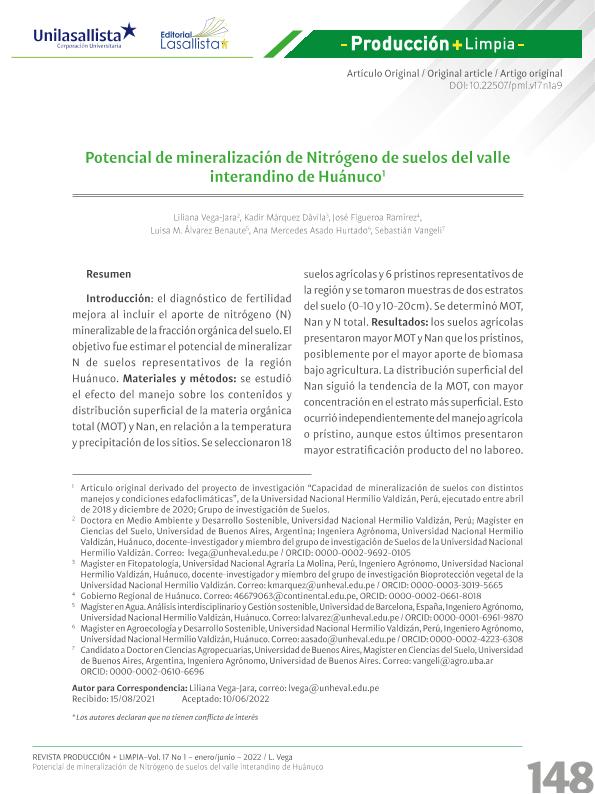Mostrar el registro sencillo del ítem
dc.contributor.author
Vega Jara, Liliana
dc.contributor.author
Dávila, Kadir Márquez
dc.contributor.author
Figueroa Ramírez, José
dc.contributor.author
Benaute, Luisa M. Álvarez
dc.contributor.author
Asado Hurtado, Ana Mercedes
dc.contributor.author
Vangeli, Sebastián

dc.date.available
2023-05-02T15:44:07Z
dc.date.issued
2022-01
dc.identifier.citation
Vega Jara, Liliana; Dávila, Kadir Márquez; Figueroa Ramírez, José; Benaute, Luisa M. Álvarez; Asado Hurtado, Ana Mercedes; et al.; Nitrogen Mineralization Potential of Soil's Inter-Andean Valley of Huanuco Potencial de mineralización de Nitrógeno de suelos del valle interandino de Huánuco; Corporacion Universitaria Lasallista; Produccion y Limpia; 17; 1; 1-2022; 148-168
dc.identifier.issn
1909-0455
dc.identifier.uri
http://hdl.handle.net/11336/196006
dc.description.abstract
Introducción: el diagnóstico de fertilidad mejora al incluir el aporte de nitrógeno (N) mineralizable de la fracción orgánica del suelo. El objetivo fue estimar el potencial de mineralizar N de suelos representativos de la región Huánuco. Materiales y métodos: se estudió el efecto del manejo sobre los contenidos y distribución superficial de la materia orgánica total (MOT) y Nan, en relación a la temperatura y precipitación de los sitios. Se seleccionaron 18 suelos agrícolas y 6 prístinos representativos de la región y se tomaron muestras de dos estratos del suelo (0-10 y 10-20cm). Se determinó MOT, Nan y N total. Resultados: los suelos agrícolas presentaron mayor MOT y Nan que los prístinos, posiblemente por el mayor aporte de biomasa bajo agricultura. La distribución superficial del Nan siguió la tendencia de la MOT, con mayor concentración en el estrato más superficial. Esto ocurrió independientemente del manejo agrícola o prístino, aunque estos últimos presentaron mayor estratificación producto del no laboreo.Los suelos estudiados pudieron agruparse en tres, según el potencial de mineralización de N. A través de la relación Nan:N total se estimaron mineralizaciones de N de 0,9 %, 2,5 % y 5 % para los distintos grupos, relacionados a las condiciones ambientales de los sitios (mayores mineralizaciones en sitios más cálidos y húmedos). Conclusiones: los suelos de Huánuco presentaron distinto potencial para mineralizar N dependiendo de la temperatura y precipitación. Estos resultados permitirían estimar mejor el aporte de N de los suelos para calcular las dosis de N a fertilizar.
dc.description.abstract
Introduction: fertility diagnosis improves by including the contribution of mineralizable nitrogen (N) from the soil organic fraction. In this work, we estimate the N mineralization potential of representative soils of the Huánuco region. Materials and methods: the management effect on the contents and surface distribution of total organic matter (MOT) and Nan, in relation to the temperature and precipitation of the sites, was studied. Eighteen agricultural soils and 6 pristine soils representative of the region, and samples were taken from two superficial soil strata (0-10 and 10-20 cm). MOT, Nan, and total N were determined. Results: agricultural soils presented higher MOT and Nan than pristine soils, possibly due to the greater contribution of biomass under agriculture. The surface distribution of the Nan followed the trend of the MOT, with a higher concentration in the most superficial stratum. This occurred independent of agricultural or pristine management, although the latter presented greater stratification as a result of non-tillage. The soils studied were grouped into three, according to the mineralization potential of N. Through the Nan:total N relationship, N mineralizations of 0.9 %, 2.5 % and 5 % were estimated for the different groups, related to the environmental conditions of the sites (higher mineralizations in warmer and more humid sites). Conclusions: the evaluated soils presented different potential to mineralize N depending on temperature and precipitation. These results contribute to a better estimation of the N contribution of soils to calculate the N doses.
dc.format
application/pdf
dc.language.iso
spa
dc.publisher
Corporacion Universitaria Lasallista
dc.rights
info:eu-repo/semantics/openAccess
dc.rights.uri
https://creativecommons.org/licenses/by-nc-nd/2.5/ar/
dc.subject
AGRICULTURAL SOILS
dc.subject
ORGANIC SOIL MATTER
dc.subject
PRISTINE SOILS
dc.subject
SITES WITH DIFFERENT CLIMATIC CHARACTERISTICS
dc.subject.classification
Ciencias del Suelo

dc.subject.classification
Agricultura, Silvicultura y Pesca

dc.subject.classification
CIENCIAS AGRÍCOLAS

dc.title
Nitrogen Mineralization Potential of Soil's Inter-Andean Valley of Huanuco Potencial de mineralización de Nitrógeno de suelos del valle interandino de Huánuco
dc.type
info:eu-repo/semantics/article
dc.type
info:ar-repo/semantics/artículo
dc.type
info:eu-repo/semantics/publishedVersion
dc.date.updated
2023-05-02T11:46:38Z
dc.identifier.eissn
2323-0703
dc.journal.volume
17
dc.journal.number
1
dc.journal.pagination
148-168
dc.journal.pais
Colombia

dc.description.fil
Fil: Vega Jara, Liliana. Universidad Nacional Hermilio Valdizán; Perú. Universidad de Buenos Aires; Argentina
dc.description.fil
Fil: Dávila, Kadir Márquez. UNIVERSIDAD NACIONAL AGRARIA LA MOLINA (UNALM); . Universidad Nacional Hermilio Valdizán; Perú
dc.description.fil
Fil: Figueroa Ramírez, José. No especifíca;
dc.description.fil
Fil: Benaute, Luisa M. Álvarez. Universidad Nacional Hermilio Valdizán; Perú. Universidad de Barcelona; España
dc.description.fil
Fil: Asado Hurtado, Ana Mercedes. Universidad Nacional Hermilio Valdizán; Perú
dc.description.fil
Fil: Vangeli, Sebastián. Universidad de Buenos Aires; Argentina. Consejo Nacional de Investigaciones Científicas y Técnicas; Argentina
dc.journal.title
Produccion y Limpia
dc.relation.alternativeid
info:eu-repo/semantics/altIdentifier/doi/http://dx.doi.org/10.22507/PML.V17N1A9
Archivos asociados
